warning NISSAN LEAF 2021 Owner´s Manual
[x] Cancel search | Manufacturer: NISSAN, Model Year: 2021, Model line: LEAF, Model: NISSAN LEAF 2021Pages: 602, PDF Size: 4.22 MB
Page 132 of 602
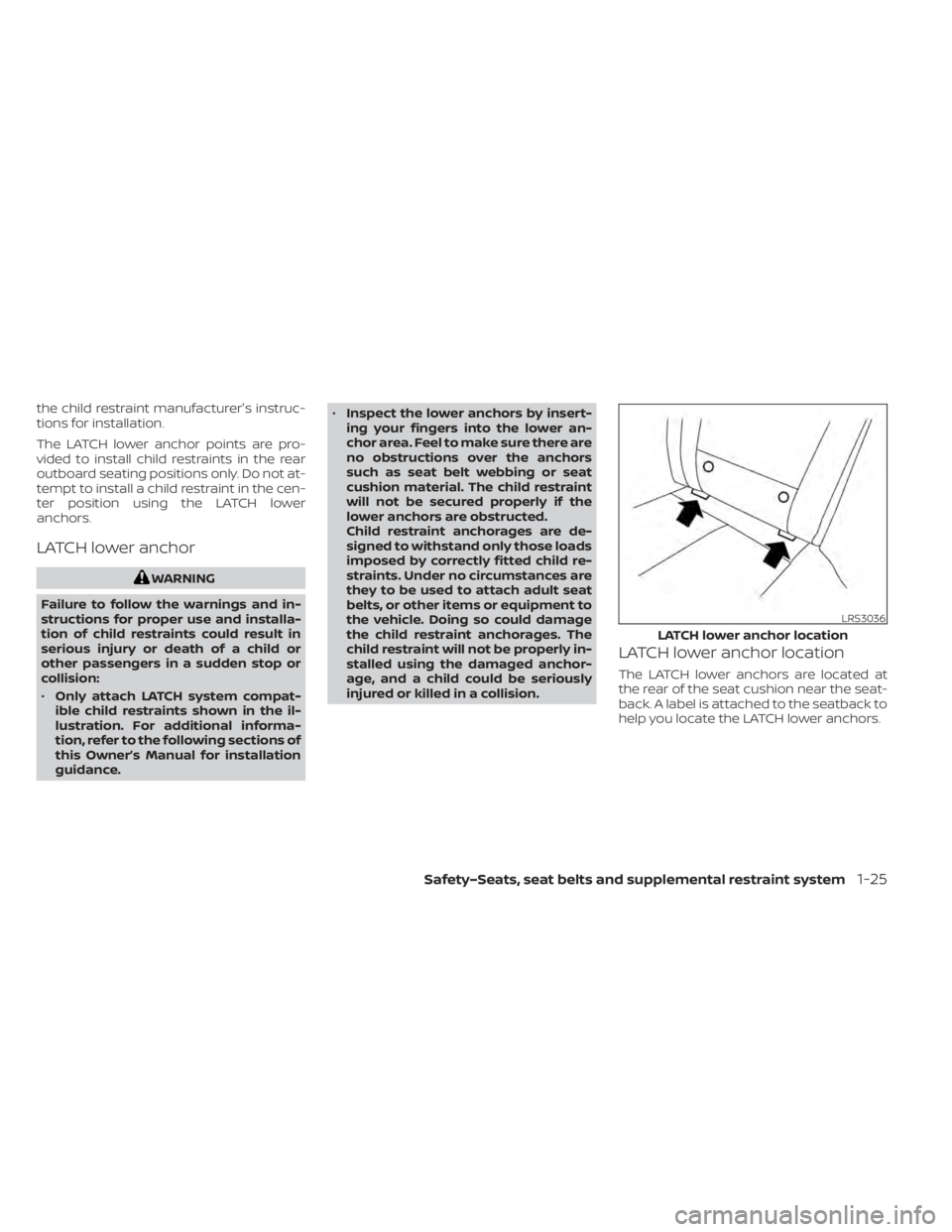
the child restraint manufacturer's instruc-
tions for installation.
The LATCH lower anchor points are pro-
vided to install child restraints in the rear
outboard seating positions only. Do not at-
tempt to install a child restraint in the cen-
ter position using the LATCH lower
anchors.
LATCH lower anchor
WARNING
Failure to follow the warnings and in-
structions for proper use and installa-
tion of child restraints could result in
serious injury or death of a child or
other passengers in a sudden stop or
collision:
• Only attach LATCH system compat-
ible child restraints shown in the il-
lustration. For additional informa-
tion, refer to the following sections of
this Owner’s Manual for installation
guidance. •
Inspect the lower anchors by insert-
ing your fingers into the lower an-
chor area. Feel to make sure there are
no obstructions over the anchors
such as seat belt webbing or seat
cushion material. The child restraint
will not be secured properly if the
lower anchors are obstructed.
Child restraint anchorages are de-
signed to withstand only those loads
imposed by correctly fitted child re-
straints. Under no circumstances are
they to be used to attach adult seat
belts, or other items or equipment to
the vehicle. Doing so could damage
the child restraint anchorages. The
child restraint will not be properly in-
stalled using the damaged anchor-
age, and a child could be seriously
injured or killed in a collision.
LATCH lower anchor location
The LATCH lower anchors are located at
the rear of the seat cushion near the seat-
back. A label is attached to the seatback to
help you locate the LATCH lower anchors.
LRS3036
LATCH lower anchor location
Safety–Seats, seat belts and supplemental restraint system1-25
Page 133 of 602
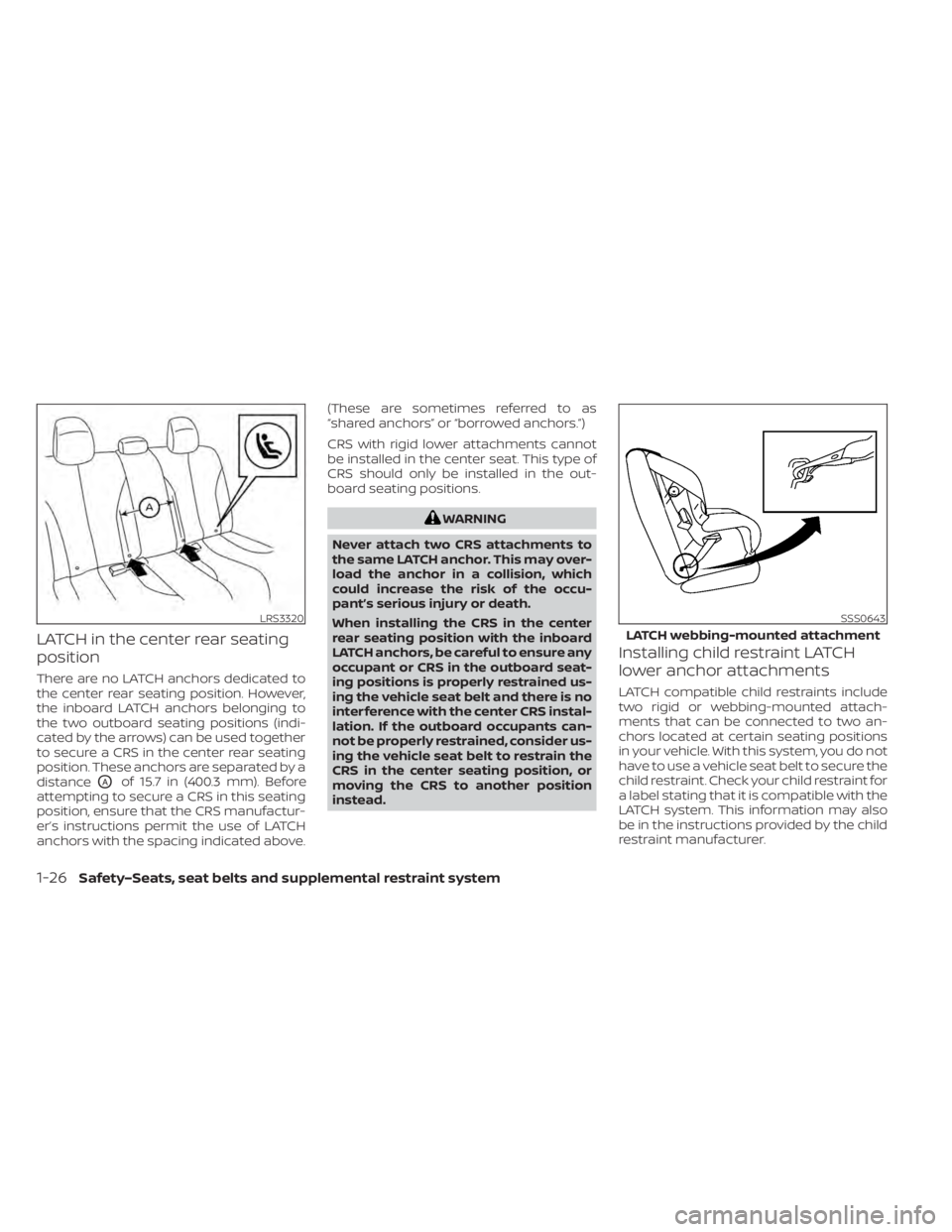
LATCH in the center rear seating
position
There are no LATCH anchors dedicated to
the center rear seating position. However,
the inboard LATCH anchors belonging to
the two outboard seating positions (indi-
cated by the arrows) can be used together
to secure a CRS in the center rear seating
position. These anchors are separated by a
distance
OAof 15.7 in (400.3 mm). Before
attempting to secure a CRS in this seating
position, ensure that the CRS manufactur-
er’s instructions permit the use of LATCH
anchors with the spacing indicated above. (These are sometimes referred to as
“shared anchors” or “borrowed anchors.”)
CRS with rigid lower attachments cannot
be installed in the center seat. This type of
CRS should only be installed in the out-
board seating positions.
WARNING
Never attach two CRS attachments to
the same LATCH anchor. This may over-
load the anchor in a collision, which
could increase the risk of the occu-
pant’s serious injury or death.
When installing the CRS in the center
rear seating position with the inboard
LATCH anchors, be careful to ensure any
occupant or CRS in the outboard seat-
ing positions is properly restrained us-
ing the vehicle seat belt and there is no
interference with the center CRS instal-
lation. If the outboard occupants can-
not be properly restrained, consider us-
ing the vehicle seat belt to restrain the
CRS in the center seating position, or
moving the CRS to another position
instead.
Installing child restraint LATCH
lower anchor attachments
LATCH compatible child restraints include
two rigid or webbing-mounted attach-
ments that can be connected to two an-
chors located at certain seating positions
in your vehicle. With this system, you do not
have to use a vehicle seat belt to secure the
child restraint. Check your child restraint for
a label stating that it is compatible with the
LATCH system. This information may also
be in the instructions provided by the child
restraint manufacturer.
LRS3320SSS0643
LATCH webbing-mounted attachment
1-26Safety–Seats, seat belts and supplemental restraint system
Page 134 of 602
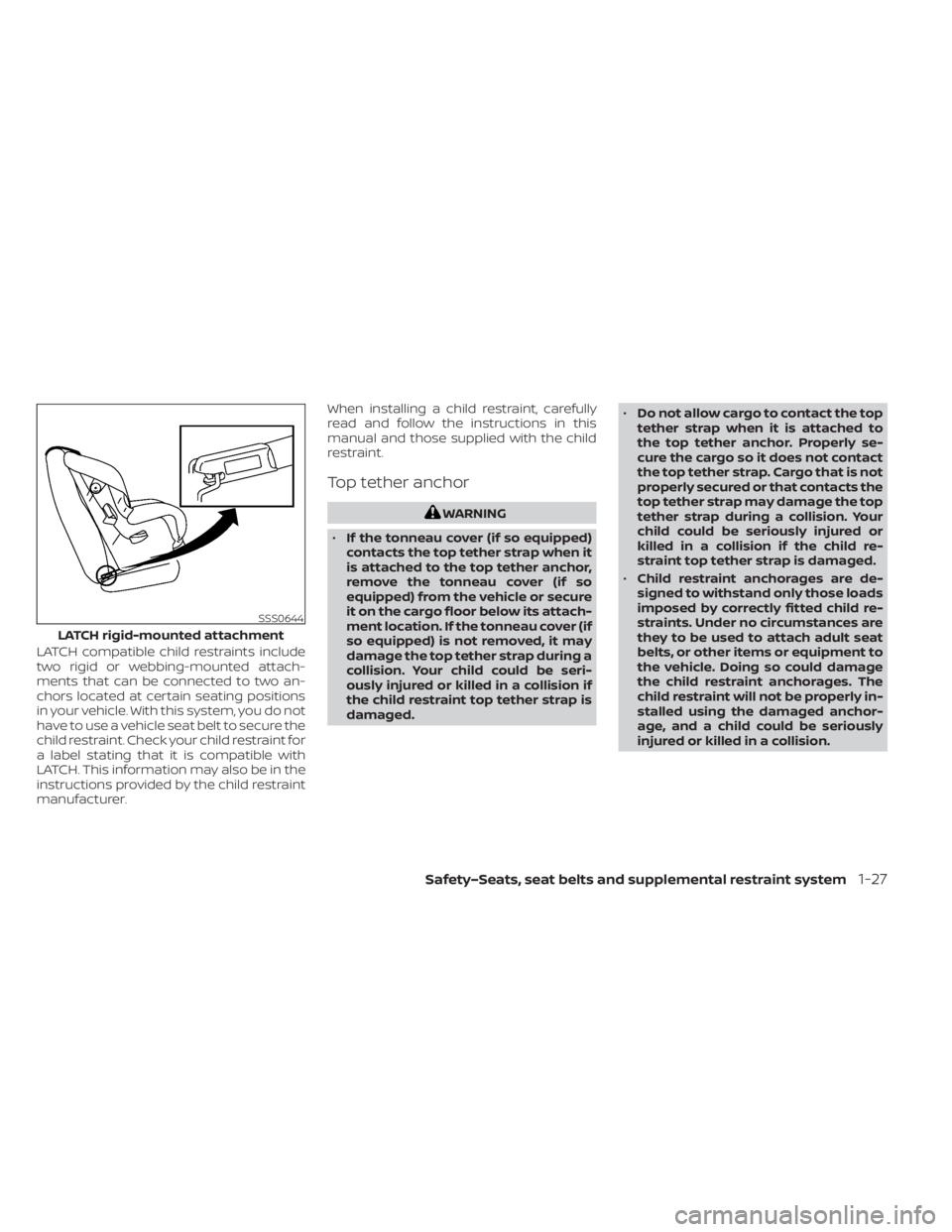
LATCH compatible child restraints include
two rigid or webbing-mounted attach-
ments that can be connected to two an-
chors located at certain seating positions
in your vehicle. With this system, you do not
have to use a vehicle seat belt to secure the
child restraint. Check your child restraint for
a label stating that it is compatible with
LATCH. This information may also be in the
instructions provided by the child restraint
manufacturer.When installing a child restraint, carefully
read and follow the instructions in this
manual and those supplied with the child
restraint.
Top tether anchor
WARNING
• If the tonneau cover (if so equipped)
contacts the top tether strap when it
is attached to the top tether anchor,
remove the tonneau cover (if so
equipped) from the vehicle or secure
it on the cargo floor below its attach-
ment location. If the tonneau cover (if
so equipped) is not removed, it may
damage the top tether strap during a
collision. Your child could be seri-
ously injured or killed in a collision if
the child restraint top tether strap is
damaged. •
Do not allow cargo to contact the top
tether strap when it is attached to
the top tether anchor. Properly se-
cure the cargo so it does not contact
the top tether strap. Cargo that is not
properly secured or that contacts the
top tether strap may damage the top
tether strap during a collision. Your
child could be seriously injured or
killed in a collision if the child re-
straint top tether strap is damaged.
• Child restraint anchorages are de-
signed to withstand only those loads
imposed by correctly fitted child re-
straints. Under no circumstances are
they to be used to attach adult seat
belts, or other items or equipment to
the vehicle. Doing so could damage
the child restraint anchorages. The
child restraint will not be properly in-
stalled using the damaged anchor-
age, and a child could be seriously
injured or killed in a collision.
SSS0644
LATCH rigid-mounted attachment
Safety–Seats, seat belts and supplemental restraint system1-27
Page 135 of 602
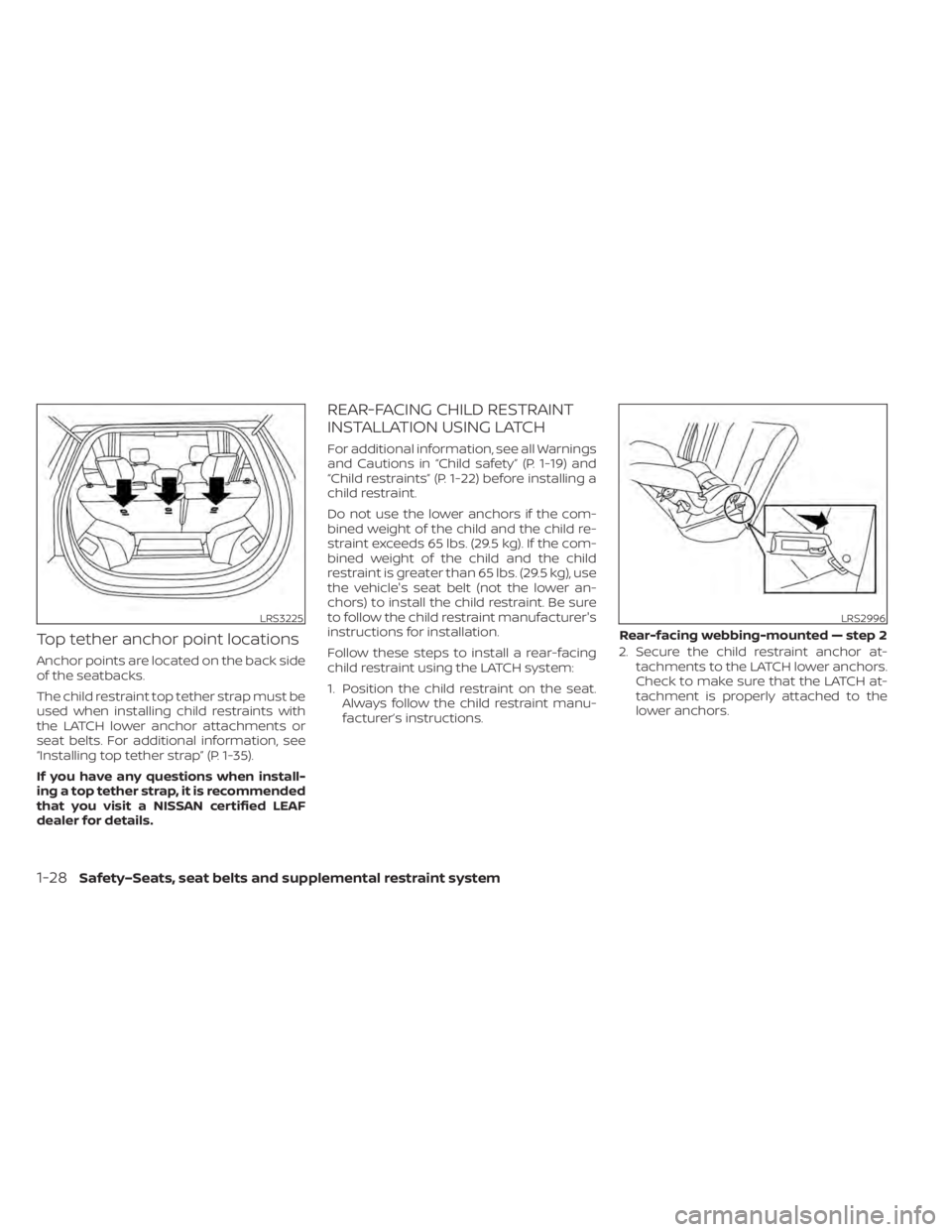
Top tether anchor point locations
Anchor points are located on the back side
of the seatbacks.
The child restraint top tether strap must be
used when installing child restraints with
the LATCH lower anchor attachments or
seat belts. For additional information, see
“Installing top tether strap” (P. 1-35).
If you have any questions when install-
ing a top tether strap, it is recommended
that you visit a NISSAN certified LEAF
dealer for details.
REAR-FACING CHILD RESTRAINT
INSTALLATION USING LATCH
For additional information, see all Warnings
and Cautions in “Child safety” (P. 1-19) and
“Child restraints” (P. 1-22) before installing a
child restraint.
Do not use the lower anchors if the com-
bined weight of the child and the child re-
straint exceeds 65 lbs. (29.5 kg). If the com-
bined weight of the child and the child
restraint is greater than 65 lbs. (29.5 kg), use
the vehicle's seat belt (not the lower an-
chors) to install the child restraint. Be sure
to follow the child restraint manufacturer's
instructions for installation.
Follow these steps to install a rear-facing
child restraint using the LATCH system:
1. Position the child restraint on the seat.Always follow the child restraint manu-
facturer’s instructions. 2. Secure the child restraint anchor at-
tachments to the LATCH lower anchors.
Check to make sure that the LATCH at-
tachment is properly attached to the
lower anchors.
LRS3225LRS2996
Rear-facing webbing-mounted — step 2
1-28Safety–Seats, seat belts and supplemental restraint system
Page 137 of 602
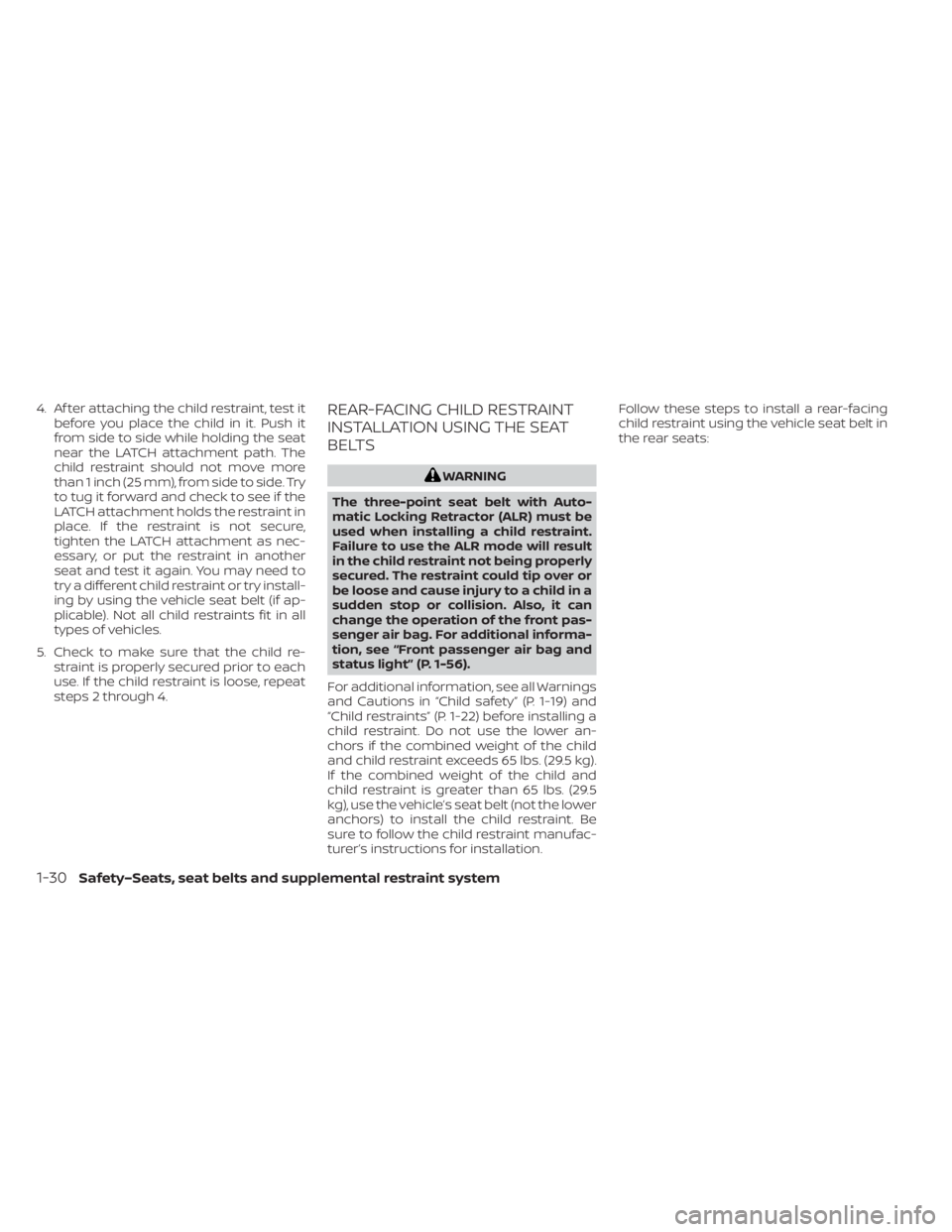
4. Af ter attaching the child restraint, test itbefore you place the child in it. Push it
from side to side while holding the seat
near the LATCH attachment path. The
child restraint should not move more
than 1 inch (25 mm), from side to side. Try
to tug it forward and check to see if the
LATCH attachment holds the restraint in
place. If the restraint is not secure,
tighten the LATCH attachment as nec-
essary, or put the restraint in another
seat and test it again. You may need to
try a different child restraint or try install-
ing by using the vehicle seat belt (if ap-
plicable). Not all child restraints fit in all
types of vehicles.
5. Check to make sure that the child re- straint is properly secured prior to each
use. If the child restraint is loose, repeat
steps 2 through 4.REAR-FACING CHILD RESTRAINT
INSTALLATION USING THE SEAT
BELTS
WARNING
The three-point seat belt with Auto-
matic Locking Retractor (ALR) must be
used when installing a child restraint.
Failure to use the ALR mode will result
in the child restraint not being properly
secured. The restraint could tip over or
be loose and cause injury to a child in a
sudden stop or collision. Also, it can
change the operation of the front pas-
senger air bag. For additional informa-
tion, see “Front passenger air bag and
status light” (P. 1-56).
For additional information, see all Warnings
and Cautions in “Child safety” (P. 1-19) and
“Child restraints” (P. 1-22) before installing a
child restraint. Do not use the lower an-
chors if the combined weight of the child
and child restraint exceeds 65 lbs. (29.5 kg).
If the combined weight of the child and
child restraint is greater than 65 lbs. (29.5
kg), use the vehicle’s seat belt (not the lower
anchors) to install the child restraint. Be
sure to follow the child restraint manufac-
turer’s instructions for installation. Follow these steps to install a rear-facing
child restraint using the vehicle seat belt in
the rear seats:
1-30Safety–Seats, seat belts and supplemental restraint system
Page 140 of 602
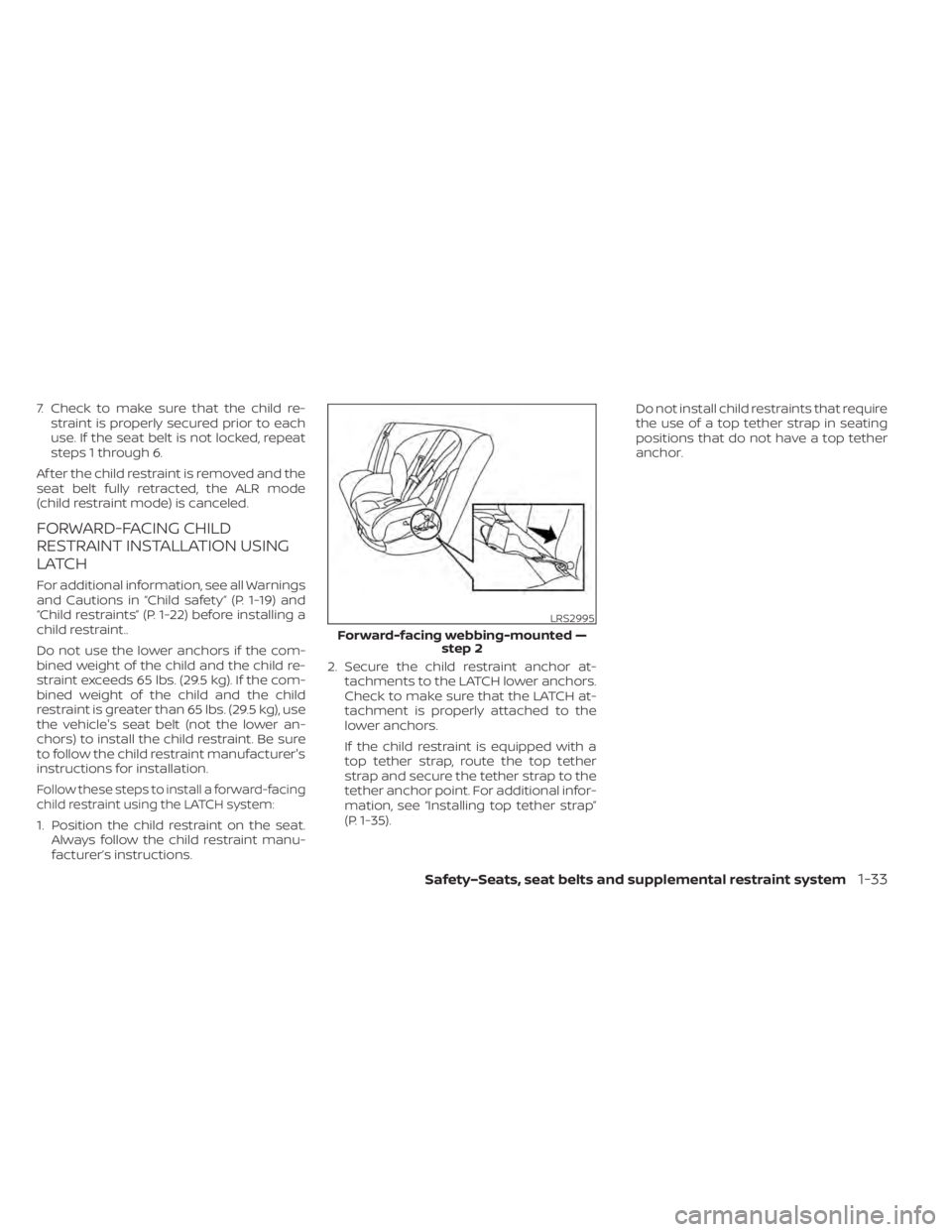
7. Check to make sure that the child re-straint is properly secured prior to each
use. If the seat belt is not locked, repeat
steps 1 through 6.
Af ter the child restraint is removed and the
seat belt fully retracted, the ALR mode
(child restraint mode) is canceled.
FORWARD-FACING CHILD
RESTRAINT INSTALLATION USING
LATCH
For additional information, see all Warnings
and Cautions in “Child safety” (P. 1-19) and
“Child restraints” (P. 1-22) before installing a
child restraint..
Do not use the lower anchors if the com-
bined weight of the child and the child re-
straint exceeds 65 lbs. (29.5 kg). If the com-
bined weight of the child and the child
restraint is greater than 65 lbs. (29.5 kg), use
the vehicle's seat belt (not the lower an-
chors) to install the child restraint. Be sure
to follow the child restraint manufacturer's
instructions for installation.
Follow these steps to install a forward-facing
child restraint using the LATCH system:
1. Position the child restraint on the seat. Always follow the child restraint manu-
facturer’s instructions. 2. Secure the child restraint anchor at-
tachments to the LATCH lower anchors.
Check to make sure that the LATCH at-
tachment is properly attached to the
lower anchors.
If the child restraint is equipped with a
top tether strap, route the top tether
strap and secure the tether strap to the
tether anchor point. For additional infor-
mation, see “Installing top tether strap”
(P. 1-35). Do not install child restraints that require
the use of a top tether strap in seating
positions that do not have a top tether
anchor.
LRS2995
Forward-facing webbing-mounted —
step 2
Safety–Seats, seat belts and supplemental restraint system1-33
Page 143 of 602
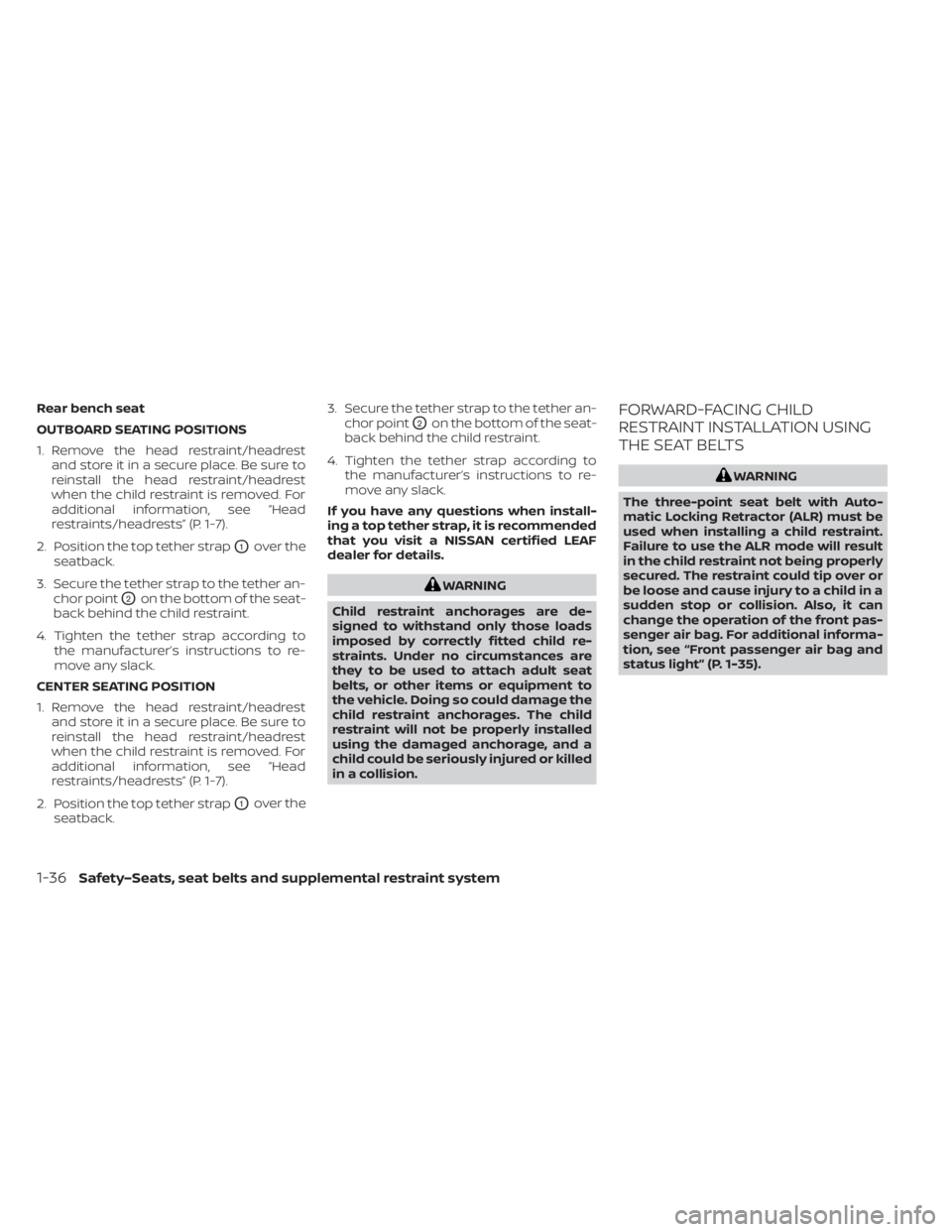
Rear bench seat
OUTBOARD SEATING POSITIONS
1. Remove the head restraint/headrestand store it in a secure place. Be sure to
reinstall the head restraint/headrest
when the child restraint is removed. For
additional information, see “Head
restraints/headrests” (P. 1-7).
2. Position the top tether strap
O1over the
seatback.
3. Secure the tether strap to the tether an- chor point
O2on the bottom of the seat-
back behind the child restraint.
4. Tighten the tether strap according to the manufacturer’s instructions to re-
move any slack.
CENTER SEATING POSITION
1. Remove the head restraint/headrest and store it in a secure place. Be sure to
reinstall the head restraint/headrest
when the child restraint is removed. For
additional information, see “Head
restraints/headrests” (P. 1-7).
2. Position the top tether strap
O1over the
seatback. 3. Secure the tether strap to the tether an-
chor point
O2on the bottom of the seat-
back behind the child restraint.
4. Tighten the tether strap according to the manufacturer’s instructions to re-
move any slack.
If you have any questions when install-
ing a top tether strap, it is recommended
that you visit a NISSAN certified LEAF
dealer for details.
WARNING
Child restraint anchorages are de-
signed to withstand only those loads
imposed by correctly fitted child re-
straints. Under no circumstances are
they to be used to attach adult seat
belts, or other items or equipment to
the vehicle. Doing so could damage the
child restraint anchorages. The child
restraint will not be properly installed
using the damaged anchorage, and a
child could be seriously injured or killed
in a collision.
FORWARD-FACING CHILD
RESTRAINT INSTALLATION USING
THE SEAT BELTS
WARNING
The three-point seat belt with Auto-
matic Locking Retractor (ALR) must be
used when installing a child restraint.
Failure to use the ALR mode will result
in the child restraint not being properly
secured. The restraint could tip over or
be loose and cause injury to a child in a
sudden stop or collision. Also, it can
change the operation of the front pas-
senger air bag. For additional informa-
tion, see “Front passenger air bag and
status light” (P. 1-35).
1-36Safety–Seats, seat belts and supplemental restraint system
Page 144 of 602
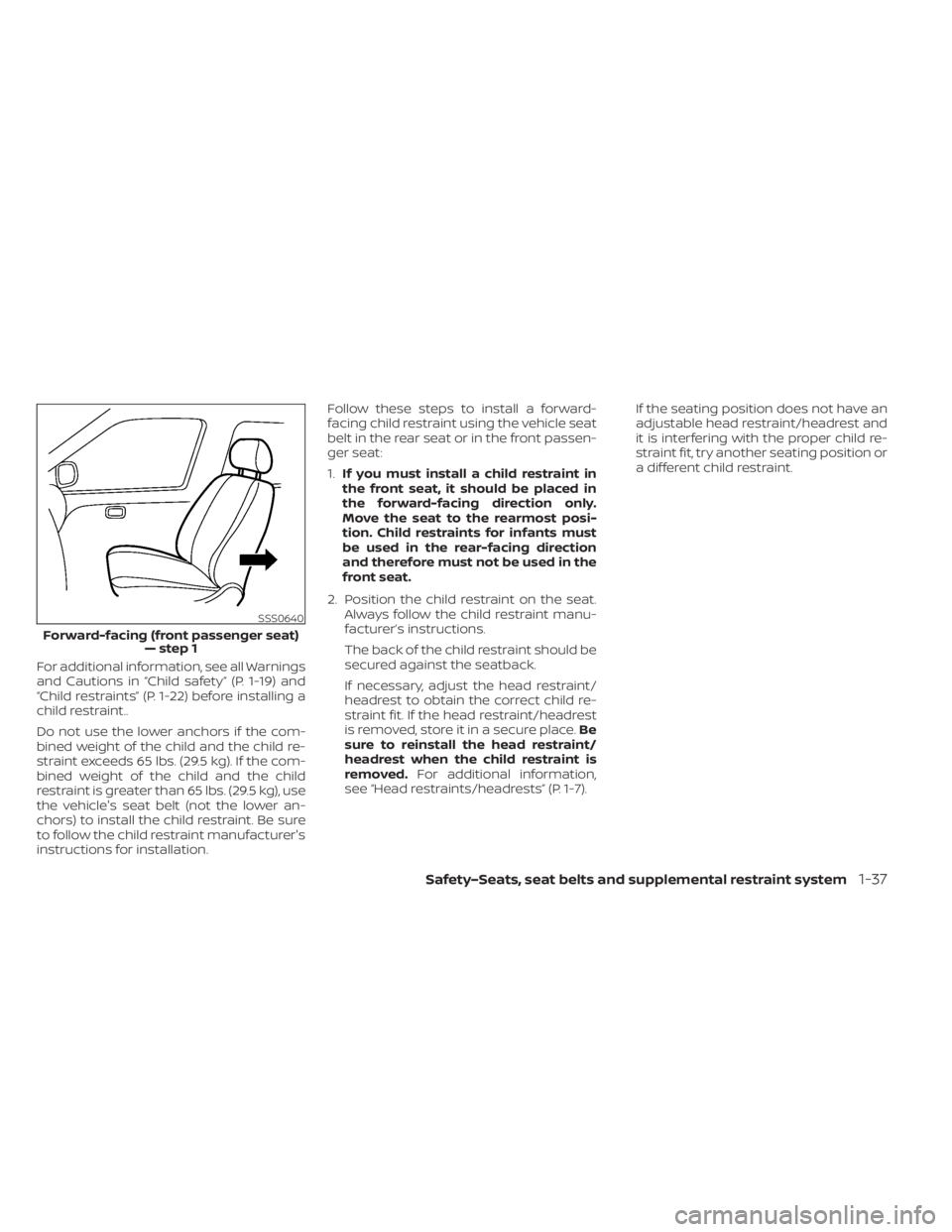
For additional information, see all Warnings
and Cautions in “Child safety” (P. 1-19) and
“Child restraints” (P. 1-22) before installing a
child restraint..
Do not use the lower anchors if the com-
bined weight of the child and the child re-
straint exceeds 65 lbs. (29.5 kg). If the com-
bined weight of the child and the child
restraint is greater than 65 lbs. (29.5 kg), use
the vehicle's seat belt (not the lower an-
chors) to install the child restraint. Be sure
to follow the child restraint manufacturer's
instructions for installation.Follow these steps to install a forward-
facing child restraint using the vehicle seat
belt in the rear seat or in the front passen-
ger seat:
1.
If you must install a child restraint in
the front seat, it should be placed in
the forward-facing direction only.
Move the seat to the rearmost posi-
tion. Child restraints for infants must
be used in the rear-facing direction
and therefore must not be used in the
front seat.
2. Position the child restraint on the seat. Always follow the child restraint manu-
facturer’s instructions.
The back of the child restraint should be
secured against the seatback.
If necessary, adjust the head restraint/
headrest to obtain the correct child re-
straint fit. If the head restraint/headrest
is removed, store it in a secure place. Be
sure to reinstall the head restraint/
headrest when the child restraint is
removed. For additional information,
see “Head restraints/headrests” (P. 1-7). If the seating position does not have an
adjustable head restraint/headrest and
it is interfering with the proper child re-
straint fit, try another seating position or
a different child restraint.
SSS0640
Forward-facing (front passenger seat)
— step 1
Safety–Seats, seat belts and supplemental restraint system1-37
Page 148 of 602
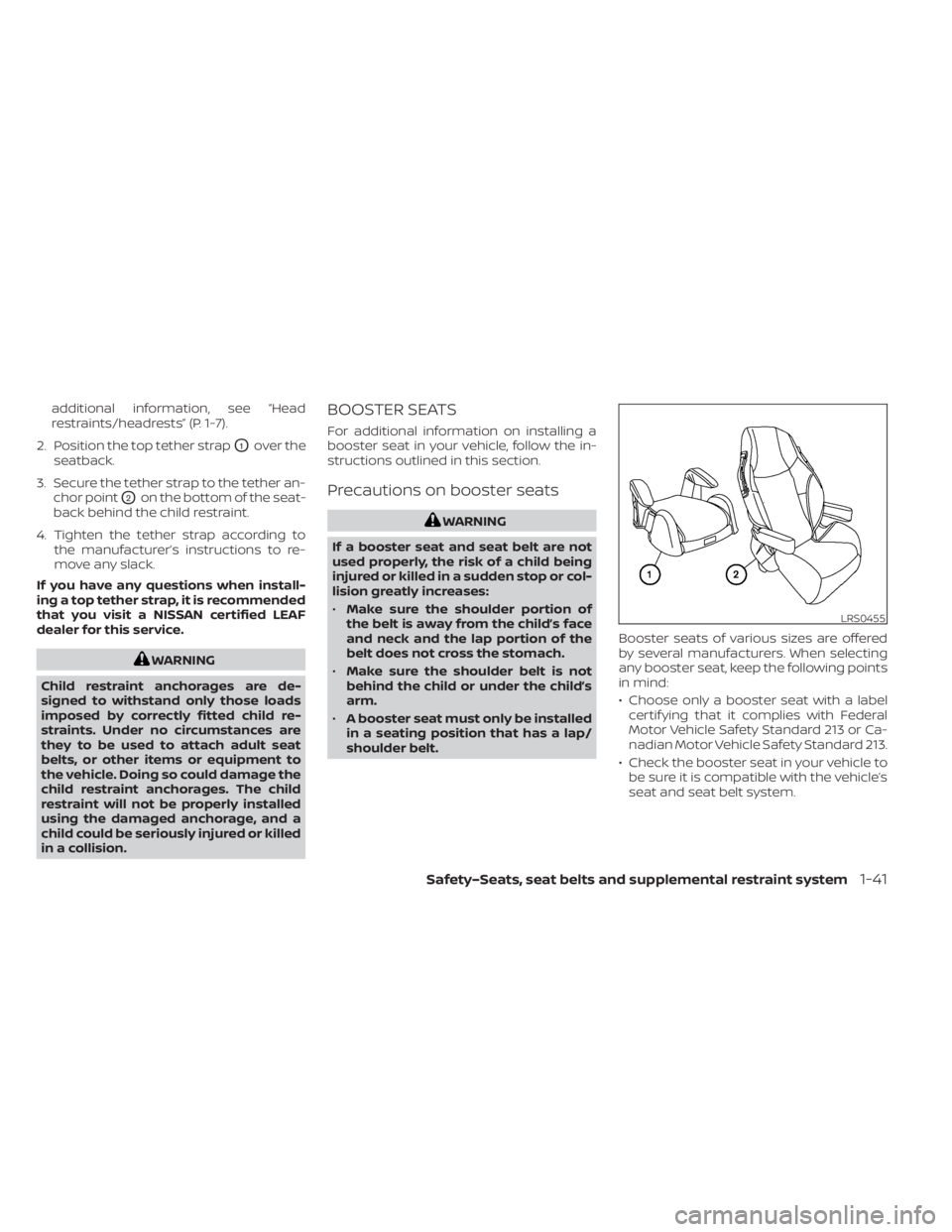
additional information, see “Head
restraints/headrests” (P. 1-7).
2. Position the top tether strap
O1over the
seatback.
3. Secure the tether strap to the tether an- chor point
O2on the bottom of the seat-
back behind the child restraint.
4. Tighten the tether strap according to the manufacturer’s instructions to re-
move any slack.
If you have any questions when install-
ing a top tether strap, it is recommended
that you visit a NISSAN certified LEAF
dealer for this service.
WARNING
Child restraint anchorages are de-
signed to withstand only those loads
imposed by correctly fitted child re-
straints. Under no circumstances are
they to be used to attach adult seat
belts, or other items or equipment to
the vehicle. Doing so could damage the
child restraint anchorages. The child
restraint will not be properly installed
using the damaged anchorage, and a
child could be seriously injured or killed
in a collision.
BOOSTER SEATS
For additional information on installing a
booster seat in your vehicle, follow the in-
structions outlined in this section.
Precautions on booster seats
WARNING
If a booster seat and seat belt are not
used properly, the risk of a child being
injured or killed in a sudden stop or col-
lision greatly increases:
• Make sure the shoulder portion of
the belt is away from the child’s face
and neck and the lap portion of the
belt does not cross the stomach.
• Make sure the shoulder belt is not
behind the child or under the child’s
arm.
• A booster seat must only be installed
in a seating position that has a lap/
shoulder belt. Booster seats of various sizes are offered
by several manufacturers. When selecting
any booster seat, keep the following points
in mind:
• Choose only a booster seat with a label
certif ying that it complies with Federal
Motor Vehicle Safety Standard 213 or Ca-
nadian Motor Vehicle Safety Standard 213.
• Check the booster seat in your vehicle to be sure it is compatible with the vehicle’s
seat and seat belt system.
LRS0455
Safety–Seats, seat belts and supplemental restraint system1-41
Page 149 of 602
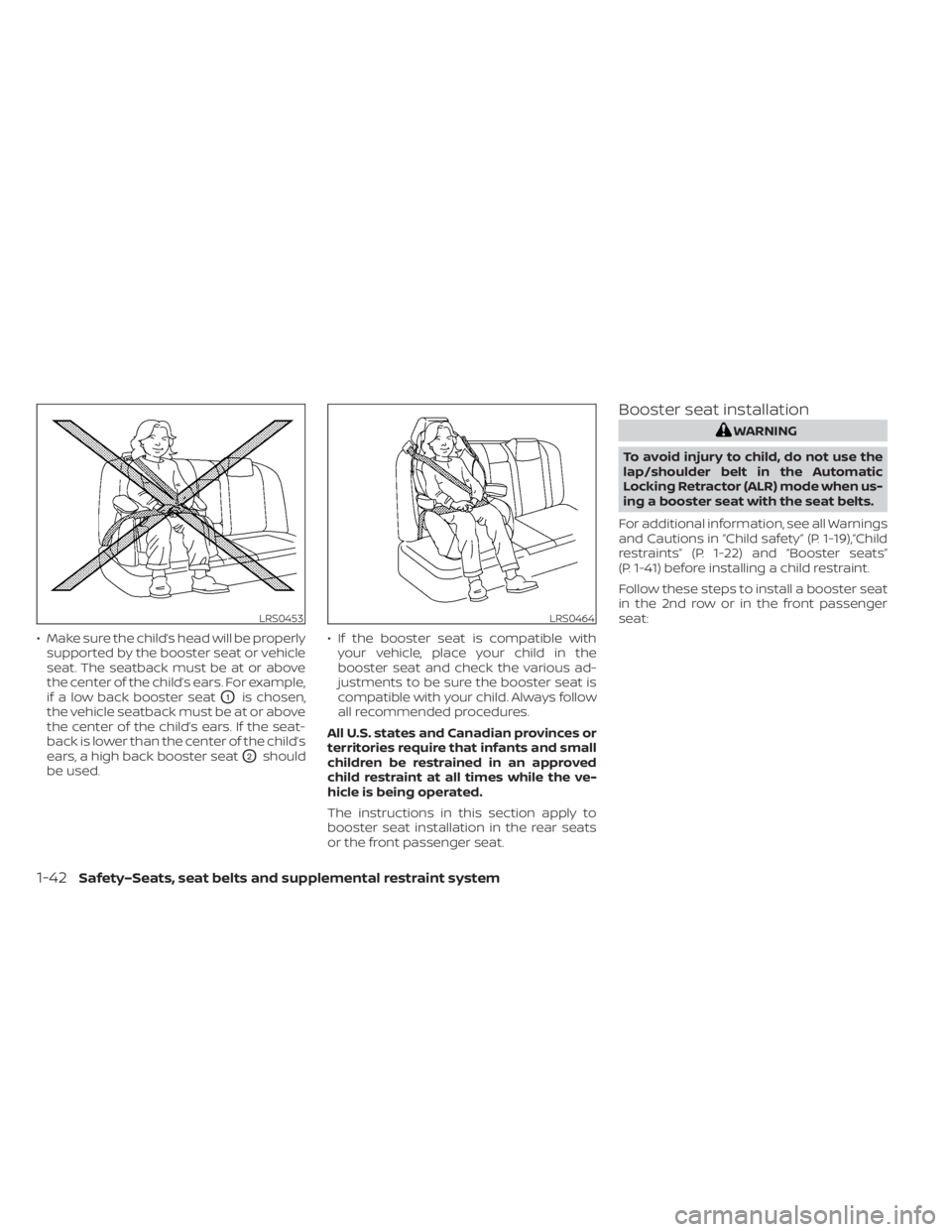
• Make sure the child’s head will be properlysupported by the booster seat or vehicle
seat. The seatback must be at or above
the center of the child’s ears. For example,
if a low back booster seat
O1is chosen,
the vehicle seatback must be at or above
the center of the child’s ears. If the seat-
back is lower than the center of the child’s
ears, a high back booster seat
O2should
be used. • If the booster seat is compatible with
your vehicle, place your child in the
booster seat and check the various ad-
justments to be sure the booster seat is
compatible with your child. Always follow
all recommended procedures.
All U.S. states and Canadian provinces or
territories require that infants and small
children be restrained in an approved
child restraint at all times while the ve-
hicle is being operated.
The instructions in this section apply to
booster seat installation in the rear seats
or the front passenger seat.
Booster seat installation
WARNING
To avoid injury to child, do not use the
lap/shoulder belt in the Automatic
Locking Retractor (ALR) mode when us-
ing a booster seat with the seat belts.
For additional information, see all Warnings
and Cautions in “Child safety” (P. 1-19),“Child
restraints” (P. 1-22) and “Booster seats”
(P. 1-41) before installing a child restraint.
Follow these steps to install a booster seat
in the 2nd row or in the front passenger
seat:
LRS0453LRS0464
1-42Safety–Seats, seat belts and supplemental restraint system